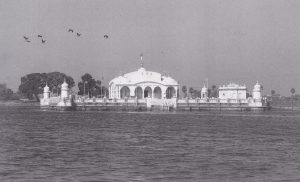Pavapuri
 A pair of footprints, cut from black stone in high relief and enshrined in this scenically situated Mahavira Mandir at Pavapuri, is the austere yet appropriate memorial of Mahavira’s attainment of nirvana. Every year at Divali, the day of his death, a big fair of lights is held at Pavapuri.
A pair of footprints, cut from black stone in high relief and enshrined in this scenically situated Mahavira Mandir at Pavapuri, is the austere yet appropriate memorial of Mahavira’s attainment of nirvana. Every year at Divali, the day of his death, a big fair of lights is held at Pavapuri.
Pavapuri in Bihar is the place where Mahavira died in 527 BC at the age of seventy- two. It was, in the words of the Kalpa Sutra translated by Hermann Jacobi: “In the fourth month of that rainy season, in the seventh fortnight of Kartika, on its fifteenth day, in the last night, in the town of Papa, in king Hastipala’s office of the writers, the Venerable Ascetic Mahavira died, went off, quitted the world, cut asunder the ties of birth, old age, and death; became a Siddha, a Buddha, a Mukta, a maker of the end of all misery, finally liberated, freed from all pain.
In that period the Venerable Ascetic Mahavira had an excellent community of fourteen thousand Shramanas (monks) with Indrabuti at their head: thirty-six thousand nuns with Kandana at their head, one hundred and fifty-nine thousand male lay votaries with Shankhashataka at their head,(and) three hundred and eighteen thousand female lay votaries with Sulasa and Revati at their head.”
Present-day Pavapuri consists of two villages separated by a mile- Pava and Puri. The latter is the Jaina tirtha. Besides the Mahavira Mandir shown above there are several other temples, among them an older and a new samavasarana shrine. As the bus service to and from Pavapuri is not very reliable, an overnight stay in a dharmashala is recommended.
